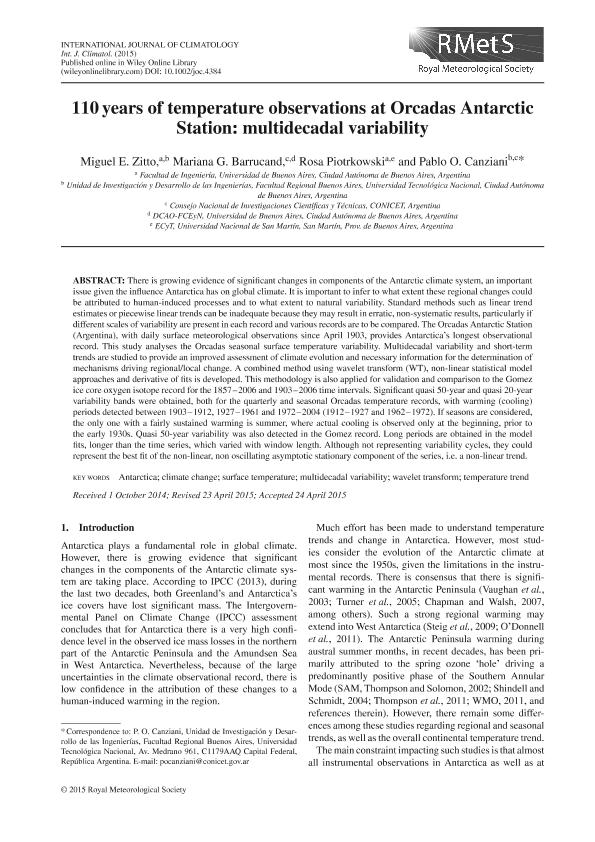Artículo
110 years of temperature observations at Orcadas Antarctic Station: multidecadal variability
Fecha de publicación:
06/2015
Editorial:
John Wiley & Sons Ltd
Revista:
International Journal of Climatology
ISSN:
0899-8418
e-ISSN:
1097-0088
Idioma:
Inglés
Tipo de recurso:
Artículo publicado
Clasificación temática:
Resumen
There is growing evidence of significant changes in components of the Antarctic climate system, an important issue given the influence Antarctica has on global climate. It is important to infer to what extent these regional changes could be attributed to human-induced processes and to what extent to natural variability. Standard methods, such as linear trend estimates or piecewise linear trends can be inadequate since they may result in erratic, non-systematic results, particularly if different scales of variability are present in each record and various records are to be compared. The Orcadas Antarctic Station (Agentina), with daily surface meteorological observations since April 1903, provides Antarctica´s longest observational record. This study analyzes the Orcadas seasonal surface temperature variability. Multidecadal variability and short term trends are studied to provide an improved assessment of climate evolution and necessary information for the determination of mechanisms driving regional/local change. A combined method using Wavelet Transform (WT), non-linear statistical model approaches and derivative of fits is developed. This methodology is also applied for validation and comparison to the Gomez ice core oxygen isotope record for the 1857-2006 and 1903-2006 time intervals. Significant quasi 50-year and quasi 20-year variability bands were obtained, both for the quarterly and seasonal Orcadas temperature records, with warming (cooling) periods detected between 1903-1912, 1927- 1961 and 1972-2004 (1912-1927 and 1962-1972). If seasons are considered, the only one with a fairly sustained warming is summer, where actual cooling is observed only at the beginning, prior to the early 1930s. Quasi 50-year variability was also detected in the Gomez record. Long periods are obtained in the model fits, longer than the time series, which varied with window length. Though not representing variability cycles, they could represent the best fit of the non-linear, non oscillating asymptotic stationary component of the series, i.e. a non-linear trend.
Archivos asociados
Licencia
Identificadores
Colecciones
Articulos(OCA CIUDAD UNIVERSITARIA)
Articulos de OFICINA DE COORDINACION ADMINISTRATIVA CIUDAD UNIVERSITARIA
Articulos de OFICINA DE COORDINACION ADMINISTRATIVA CIUDAD UNIVERSITARIA
Citación
Zitto, Miguel Eduardo; Barrucand, Mariana Graciela; Piotrkowski, Rosa; Canziani, Pablo Osvaldo; 110 years of temperature observations at Orcadas Antarctic Station: multidecadal variability; John Wiley & Sons Ltd; International Journal of Climatology; 36; 2; 6-2015; 809-823
Compartir
Altmétricas




